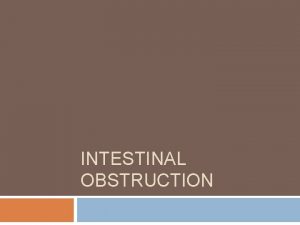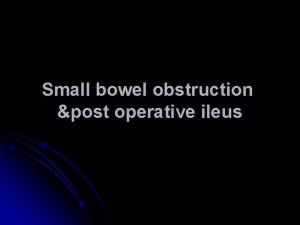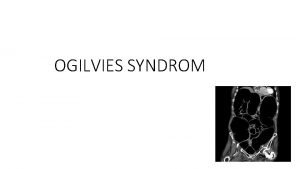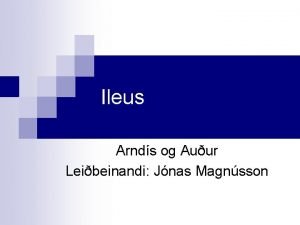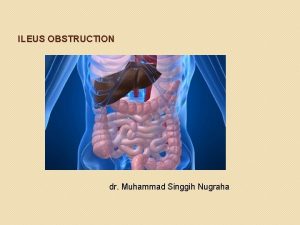Introduction Ileus This module covers an area of







- Slides: 7

Introduction : Ileus This module covers an area of missed opportunity. While it may seem like a small thing, records of patients who in all likelihood were treated for paralytic Ileus do not end up documented and coded. This can happen in spite of the clinical complications, specificity, and severity of illness depicted in the chart. The following module offers some simple insights into a common problem. This condition is likely prevalent, so the question becomes "When does it earn its place as a complicating factor? " The most simple answer for the physician is that this isn't really something the doctor should be worried about. Treat the patient appropriately and focus on positive outcomes. Regarding Ileus, document how the Ileus was treated when the problem is resolved in the medical record. Was the treatment standard and the issue resolved in its natural course, without physician concern or intervention? What did you have to do to resolve the issue? Include this in your clinical documentation when you resolve the problem.

Paralytic Ileus v Ileus Definition: Cessation of intestinal peristalsis, leading to the accumulation of fluid and gas in the bowel; also known as pseudo-obstruction, as it occurs in the absence o. f physical obstruction

Paralytic Ileus v Abdominal surgery and drugs that interfere with the intestine’s movements are a common cause. v Despite numerous advances in surgical technique and perioperative care, postoperative ileus continues to be one of the most common and expected aspects of abdominal surgery. v Ileus commonly occurs for 24 to 72 hours after abdominal surgery, particularly when the intestines have been manipulated. This is an expected course of the recovery. v Many authors suggest that a ileus is an expected phase of the recovery period for any intra-abdominal procedure, and only an ileus lasting greater than 5 days is abnormal – to be termed a prolonged Ileus. v Under this definition, fully 40% of patients undergoing laparotomy experience prolonged Ileus. v In your clinical interpretation when do you expect bowel function return? v 72 hours, 96 hours or 120 hours?

Paralytic Ileus v A few common Ileus clinical indicators: v Abdominal distention on exam v Abdominal pain v Accumulation of fluid and gas in the bowel per imaging v Nausea and vomiting v Lack of bowel movement or passing of flatulence A paralytic ileus can prolong hospital stays, increasing medical costs and frustrating patients and surgeons, as well as impacting severity of illness and risk of mortality. It is essential to document supporting clinical findings that support the prolonged ileus diagnosis when it occurs to validate the extended stay and additional resources necessary to treat a paralytic ileus.

Paralytic Ileus v In the coding world, including the word “post-op” with a diagnosis infers the condition is a complication of the surgery. v When post-op ileus is documented coders must follow coding rules that direct them to assign a complication code as well as the code for ileus. v In this example; postop ileus is documented and will be coded as such: v v K 91. 89 – Other post-procedural complications and disorders of the digestive system v K 56. 0 – Paralytic ileus When you document ”post-op Ileus”, is it your intention to state the patient is in the post-op period (time frame)? OR v Is it your intent that the ileus is a resulting complication of the surgery?

Documenting Paralytic Ileus v A prolonged ileus becomes a significant condition when it requires additional time and resources. Ie. Increased length of stay, IV fluids, etc) and should be documented. v Document the etiology (if known) and document the cause and effect relationship. v If one is uncertain as to the etiology of an ileus, it is acceptable and encouraged to use terms such as “probable, ” “possible, ” or “suspected, ” etc. to describe this diagnosis (or any other diagnosis). To qualify, these terms must end up in the discharge summary, so attaching them to the diagnosis in the detail section of the problem list is very important. v Coders can only code what is documented and MUST follow coding guidelines. v Document all co-morbid conditions treated during this hospitalization. Make sure to write about them in your assessment.

Q & A A prolonged ileus becomes a significant condition when it requires additional time and resources. Ie. Increased length of stay, IV fluids, etc) and should be documented. (True) A paralytic ileus can prolong hospital stays, increases medical costs and frustrates patients and surgeons also impacting severity of illness and risk of mortality. (true) There is not need to document the etiology (if known) and document the cause and effect relationship (false) Providers may use terms such as “probable, ” “possible, ” or “suspected, ” etc. to describe this diagnosis (or any other diagnosis). (True)
